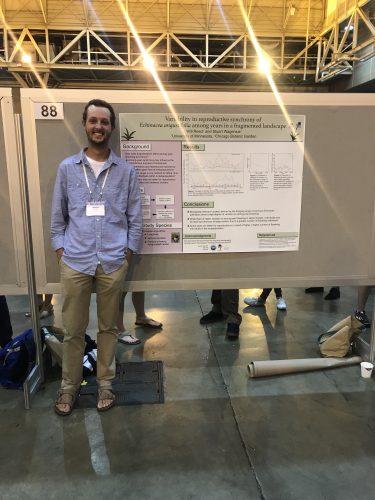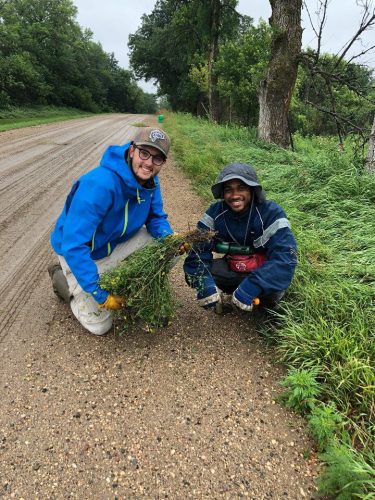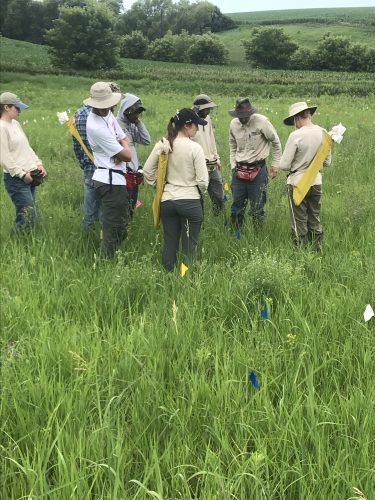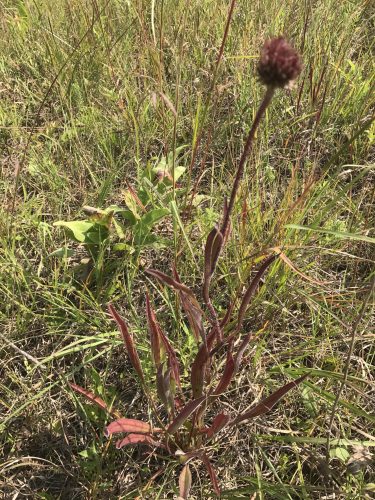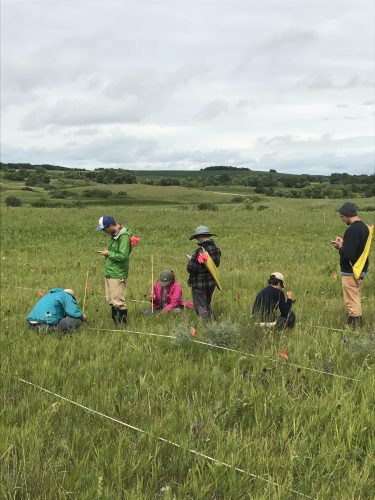|
|
Hello from New Orleans!
Yesterday I presented my poster on the general patterns of Echinacea flowering in our study area! I found that there are patterns of high and low flowering across all of the remnants that we study. I also found that there are good years to flower for the metapopulation that we study (and bad years..). What could be causing lots of echinacea to flower in the same year?
I presented my poster at Poster Session 18 – “Habitat Structure, Fragmentation, Connectivity” from 4:30-6:30. I had lots of visitors stop by to hear about my results and got to meet several Echinacea Project Alums!
 Me and my poster <3 Here is my poster:
Wills ESA Poster PDF
Today, the weather was not in favor of getting field work done. We spent the morning working on getting things ready for some of the Echinacea Project’s biggest tasks like Demography and Measuring. We also spent time working on our independent projects and learning to code in R.
At lunch, Jennifer gave a practice version of her upcoming talk at the Botany meeting in Rochester, MN. We learned about the maintenance of pollen color in Bellflowers.
After lunch, there was a brief ‘break’ in the rain so we headed out to Tower Road to remove some bird’s foot trefoil. We have been removing this invasive for several years and I think that our progress is easily seen! Evan and I found one monster plant that took the two of us to remove (see picture). It was a bummer to miss a day of field work but it was nice to have some time to catch up on inside tasks.
 Evan and I showing of our trophy
Today was the historic Big Event 2: Electric Boogaloo and while the rain may have tried to thwart our attempts to quantify how different pollinator taxa affect male fitness, Team Echinacea overcame and we had a great time watching pollinators in experimental plot 2 once the rain cleared. We saw lots of bees visiting Echinacea and spent lots of time running between plants to shoo away bees. We also played some fun games during downtime (in between the rushes of bee visits). Andy taught us Contact, which is a fun game where you try and guess the word the other person is thinking of.
 The Team watching and shooing bees in P2
After we finished with TBE2EB (The Big Event 2: Electric Boogaloo) We had just a little bit of time to work on miscellaneous tasks. I worked on preparing some information to assist with planning for the big demography project and others visited Hegg Lake to decapitate any traitorous Echinacea pallida that might be lurking around.
We are looking forward to a hot day tomorrow, stay tuned for updates on The Big Event 3: Return of the Bees (Although my vote for naming #3 was The Big Event 2: Electric Boogaloo 2: Electric Boogaloo, much more systematic in my opinion).
Have a great night Flog!
Will
Hi Flog!
I just wanted to give you all a quick update on the heritability of flowering time project I have been working on (for a long time)! We collected data on the phenology of the plants at experimental plot 2 during the summers of 2015 and 2016 and the phenotypes of those individuals to the phenotypes of their parents in 2005. Jennifer Ison began this project as a part of her dissertation in 2006 and I was lucky enough to pick it up when the individuals in experimental plot 2 really began to flower.
Since we collected data in ’15/’16 we have been working on analyses to determine the amount of variation in flowering time that is heritable. We found that there is substantial heritability for both onset of flowering and duration of flowering. Both of these traits are critical in describing the synchrony of an individual compared to the population and for determining the number of mating opportunities an individual will have in a season.
Today we submitted the manuscript that describes these results to Evolution. Drafting this manuscript has been an excellent learning opportunity for me and I have been lucky to work with some amazing scientists and writers. Thank you to my co-authors: Jennifer Ison, Stuart Wagenius, Frank Shaw, and Ruth Shaw.
Hello Flog! Today was a great day out on the prairie. We got a lot of important things done, but more importantly, we had fun getting them done! Weather-wise it was a nice day, we were slightly concerned at lunch after a brief spurt of rain, but things cleared off and the beautiful weather held through the afternoon. While temperatures in western MN have gone down a bit, the mosquito population still seems enormous.
In the morning some folks worked on independent projects, a select few worked on planning a top secret project ‘The Big Event’ (flog post coming soon to an Echinacea project flog near you). I worked in experimental plot one with Kristen, Andy, Anna, and Michael to find and record all flowering heads, Its a big job but luckily not as big as experimental plot 2!
 Kristen and Andy next to their prized flowering Echinacea I took a break at about 10:30 to learn more about our brand new GPS unit named Darwin. This is an excellent investment for the project and will help us get a lot more field work done. It has many more useful functions than our GRS-1 units which seem to be terminally ill.
At lunch, we discussed the finer points of the 40-hour work week.
Post lunch many of us went back out to experimental plot 1 to find and record information on the Hesperostipa spartea that are planted near the Echinacea in that plot. Since it is a grass it can be difficult to spot, I was lucky enough to work with Zeke who seems to have been blessed with the ‘Stipa Sense’ or the ability to spot these plants from at least 2 miles away on a foggy morning.
 The team learning how to find Stipa
Have a great night!
Will
Echinacea Project 2018
Ecology and Evolutionary Biology, University of Colorado Boulder, 2018 –
Ecology, Evolution, and Behavior, University of Minnesota, 2018
Research Interests
I am broadly interested in the genetics of plant populations as well as investigating how phenotypes are expressed in different environments. I have estimated the heritability of flowering time in Echinacea angustifolia and I would like to evaluate selection on flowering time. I am also interested in learning about patterns of flowering across a fragmented landscape, like the one we study in western MN!
Statement
I am from Alexandria, MN, about 20 minutes east of our study site. This will be my fifth year working on the project! In my free time, I like to do outdoor things, I particularly enjoy fly fishing and hiking. I also enjoy finding and listening to new music. This summer I plan to spend lots of my free time playing with our new puppy!

Today was maybe the best weather day of the summer in my opinion, a nice breeze all day and just below 70 degrees. We took full advantage of the great weather and went to our Landfill remnant to finish doing total demo. We only did total demo on part of the site but, we still visited 687 previously flowering Echinacea and even found some never before seen individuals!
It didn’t take long to finish demo at the Landfill, so we did some miscellaneous jobs for the rest of the morning. In the afternoon we went to Hegg Lake WMA to find any remaining individuals of the treasonous Echinacea pallida. We found three pallida and quickly relieved them of their heads. One of the individuals we found appeared to have aster yellows, a disease that affects many species in the Aster family including E. angustifolia and E. pallida. It is possible that pallida, a non-native, could outcompete the native variety (hence the decapitation to prevent the spreading of achenes). So it is good to know that like our much loved Echinacea angustifolia, Echinacea pallida can get sick too!
 An E. pallida with what appears to be a case of aster yellows.
Our numbers are slowly dwindling (if only temporarily), as Stuart headed back to Illinois for the weekend. Many of us only have a few days left. It’s hard to believe that the field season is almost over, and we have so much to do!
We started off the day by doing doing total demo at our Aanenson remnant and harvesting some Echinacea heads from the remnants so that we can estimate seed set in natural populations!
We finished total demo at Aanenson and after some mishaps with a two ton hay bail we headed to Loeffler’s Corner to do some more total demo. It started misting almost immediately after we arrived and the rain slowly picked up. Our new GPS unit is water proof so this shouldn’t have stopped us but sadly our visors are not so we had to head in for the day. We spent the rest of the afternoon doing various indoor activities from learning R to pinning collections from the yellow pan traps!
Happy Weekend!
Today was a really chilly day for August. The high temperature was around 60 degrees and it rained most of last night. We did some inside work this morning while we waited for it to dry off, one team (Wes, Ashley, and Alex) went to north of railroad crossing to do total demo but, the weather did not cooperate.
This afternoon we worked on measuring plants in experimental plot 2. We began measuring in p2 midway through the morning on Tuesday. We finished measuring almost 4000 positions today. That’s only 2 days! Probably a new record measuring p2. The data we collected in p2 over the last couple days will be added to the long-term fitness data set for those plants which were planted in 2006.
We look forward to slightly warmer weather tomorrow!
 Three groups diligently measure in experimental plot 2!
“I love PBORY” – exclaimed Lea as we headed out to learn the total demo protocol. PBORY is the acronym for the order we place flags at the locations of plants that we collect demographic data at. First a gps operator finds the plants using coordinates from previous years, they then place a flag at the location. The color of said flag is dictated by the number of the location they are at. If the location number ends in 1 the the operator puts down a pink flag, a 2 gets a blue flag, 3 gets orange, 4 gets red, and 5 gets yellow, hence PBORY. The acronym helps the team keep the locations straight and get the correct demographic info for each location. The demographers follow the gps operator and collect info at each of the locations.
All of the data we are collecting contributes to the over 20 year long demographic census of Echinacea angustifolia. Some plants have been alive the entire time!
Today we did total demo at our “south of golf course” remnant population which is new to much of the team since we are not collecting phenological data from that population.
We found lots of plants that were still alive from 10 or more years ago, some were even completely surrounded by poison ivy.
 “I love PBORY”  Wes , Tracie, Anna, and Gretel do Total Demo at South of Golf Course
|
|
